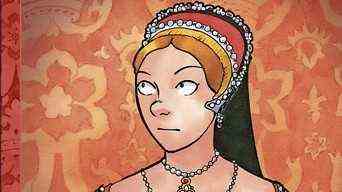The time travel to the most diverse locations of earth-shattering events that Kristina Gehrmann has undertaken in recent years would enliven any history lesson. The young Hamburg illustrator and author followed in the footsteps of John Franklin’s tragic Arctic expedition from 1845 to 1848, she snuck into Chicago’s meat factories at the beginning of the 20th century and is now penetrating the heart of a world power of the 16th century – in search of the first English one Queen, Queen Mary (1518-1558). “Bloody Mary – The Story of Mary Tudor” is the name of Gehrmann’s 330-page graphic novel, which was colored for the first time.
Although these journeys through time have nothing to do with each other at first glance, the readers soon notice what characterizes Gehrmann’s pictorial narratives in terms of style and content: well-timed changes of perspective that suggest that one would get close to the action from a wide variety of perspectives. Expressive facial features of the people, despite the simple-looking, but precisely set lines. In terms of content, the artist focuses on life behind people’s facades. She illuminates even the darkest corners of the characters, their suffering, their soul pain, their doubts, their contradictions, their humiliations.
Kristina Gehrmann does not neglect the needs, fears and hopes of the poor population in town and country.
And it changes, with dramaturgical skill, from intimate glances at the people to events that influence them, but also to marginal phenomena that reflect the moods outside the immediate milieu. In the case of Mary Tudor, it is the well-researched life at court, there are insights into the everyday lives of simple servants, as well as into the machinations of courtiers and string pullers in the nobility and clergy. Kristina Gehrmann does not neglect the needs, fears and hopes of the poor population in town and country. The question that drives her: How does Mary Tudor become what she has become? Again and again the artist allows Mary to have her say: “I am a princess of England. My parents are King Henry VIII and Queen Catherine of Aragon. A God-given, unchangeable fact in an ideal, orderly world: God’s plan!” Only the plan in a completely unhealthy world looks different from what the inquisitive, happy and well-behaved child Mary dreams of.
A look at Kristina Gehrmann’s comic.
The decision of her moody father to annul his marriage to Katharina and have his daughter declared a bastard provokes Mary’s fighter nature. She insists on her position as the rightful heir to the throne and she defends the Roman Catholic faith against Henry VIII, who declares himself head of the Reformed Church in England and demands absolute devotion from Mary. Only restraint and diplomatic submission save her from death as a heretic. The fickle, ailing father even reinstates Mary in the line of succession. The bitter irony of the story is the bitter irony of the story, the background of which Kristina Gehrmann delicately sheds light on, without any inclination to actionist image sequences, that the clever and strong faithful woman on the throne herself becomes a feared ruler and merciless persecutor of the Lutheran faith.
Unusually close views behind the facades of people and legends – this is what distinguishes Kristina Gehrmann’s graphic novels. You actually want it as a motivational background to history lessons. The next “Tudorial” is already in the works: the life of Mary’s half-sister and heir to the throne Elizabeth I (from 10 years)

